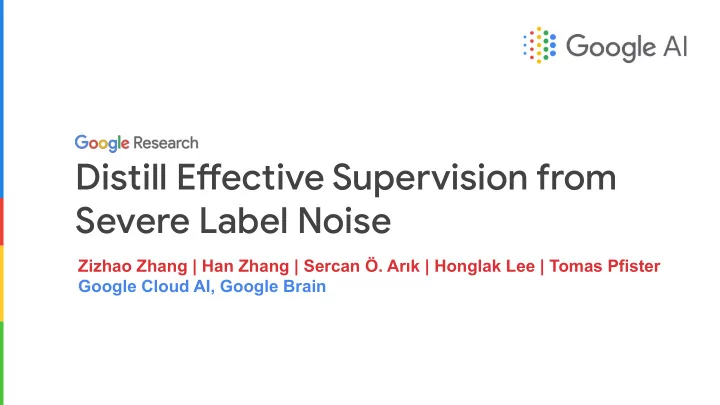

Distill Efgective Supervision from Severe Label Noise Zizhao Zhang | Han Zhang | Sercan Ö. Arık | Honglak Lee | Tomas Pfister Google Cloud AI, Google Brain
Noisy label in Practice Practically-common scenario Previous work MentorNet, Jiang et al. ICML 2018 Crowd-sourcing, web search Learning-to-reweight, Ren et al, ICML 2018 Trusted Noisy Model dataset dataset Optimization TruestedData, Hendrycks et al., NeuIPS 2019
Motivation Experimented on CIFAR100 uniform noise Previous methods still sufger from high label noise. How can do betuer utilize the hidden correct labels in the big noisy-label datasets? Trusted Noisy dataset Our method estimates dataset Drop noisy labels Data Coeffjcients Semi-supervised learning Noise-robust learning with a generalized meta learning framework to distill efgective Green line: Fully-supervised baseline without label noise. supervision from label noise. Blue line : Noise-robust methods can be severely afgected if the label noise ratio is high, e.g. > 50% label noise. Yellow line : Semi-supervised learning (SSL) methods, which discard labels of the large noisy-label dataset. Red line : Our method signifjcantly improves noise-robust training.
Method Key training steps Obtain initial pseudo label candidates ● Contrust meta re-labeling and ● re-weighting in a generalized meta learning framework. Re-labeling is formulated as a difgerential selection problem between estimated labels and original labels. Construct composed losses with ● estimated data coeffjcients. Train a model for one step. ● Key insights (see paper): Betuer initial pseudo labels ● Betuer regularizations ●
Initial Pseudo Labels Inspired by MixMatch, Beruhelot et al, NeurIPS, 2019 Pseudo label estimator average predictions of augmentations and then apply sofumax temperature calibration For augmentation, we use AutoAugment/RandAugment: geomatic/color transformation →fmip→random crop→cutout
Pseudo labels need consistent predictions 3 augmentations Pred 1 Pred 2 Pred 3 Pseudo labels inconsistent predictions Flat Consistent predictions Sharp Consistency enforcing
Training overview The training losses are composted by multiple cross-entropy losses using learned data coeffjcients (weights and pseudo labels) Introduce probe data in actual updating: MixUp is used to "gently" introduce the probe data with possibly-noisy data as training data
Experiments State-of-the-aru over many benchmarks
Experiments with uniform noise Two used networks: WRN28-10 (default) and ResNet29 (very light) Table 1: CIFAR10 with uniform noises. - Upto 9% (86.8% -> 93.7%) improvement. - Outpergorm others with a much smaller ResNet and uses 1 trusted train data/class. 0.01k: 1 probe image per class Table 2: CIFAR100 with uniform noises. - Upto 56% (48.2% -> 75.5%) improvement. - Outpergorm others with a much smaller ResNet and uses 1 trusted train data/class. 0.1k: 1 probe image per class Table 2 : CIFAR100 with different uniform noises. - Upto 56% (48.2% -> 75.5%) improvement. - Outperform others with a much smaller ResNet and merely 1 clean image per class.
Experiments with semantic noise Table 1: Asymmetric noise on CIFAR10. Table 2: Experiments with semantic noise where labels are generated by a neural network trained on limited data. The resulting noise ratio is shown in parentheses. * Trained by us
Large-scale experiments Table 1: WebVision 2M comparison the on min and full version (10 clean ImageNet training images per class is used). - Upto 25% (63.8% -> 80.0%) improvement. - Outpergorm MentorNet even with a much smaller ResNet50 compared with default InceptionResNetv2. mini: 60k (50 class) full: 2M (1000 class) Table 2: Food101N comparison.
Efgectiveness of meta re-labeling Study on CIFAR100 Data coeffjcients: exemplar weights and labels Binary selection formulation: Smaller \lambda favors pseudo labels
Conclusion Our method Estimates Data Coeffjcients, exemplar ● htups://github.com/google-research/google-rese weights and labels, to distill efgective arch/tree/master/ieg supervision for noise-robust model training. ● Signifjcantly outpergorms previous methods and sets new state of the arus on most benchmarks.
Recommend
More recommend